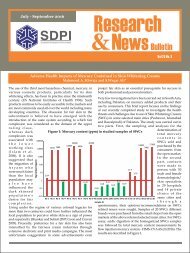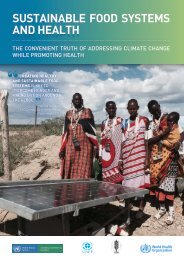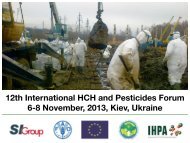Women and Chemicals
WomenAndChemicals_PublicationIWD2016
WomenAndChemicals_PublicationIWD2016
Create successful ePaper yourself
Turn your PDF publications into a flip-book with our unique Google optimized e-Paper software.
What are the main harmful substances that women are exposed to?<br />
Heavy metals – lead <strong>and</strong> mercury<br />
Mercury<br />
<strong>Women</strong> are exposed to mercury directly as well as indirectly<br />
from the air they inhale <strong>and</strong> from the water <strong>and</strong> the food that<br />
they consume every day. As tests have shown, already many<br />
women have elevated levels of mercury in the blood, hair, urine,<br />
<strong>and</strong> breast milk.<br />
Mercury is toxic for the nervous system, the cardiovascular<br />
system <strong>and</strong> the kidneys. “It is generally accepted that developing<br />
organ systems (such as the foetal nervous system) are the most<br />
sensitive to toxic effects of mercury. Foetal brain mercury levels<br />
appear to be significantly higher than in maternal blood, <strong>and</strong> the<br />
developing central nervous system of the foetus is currently regarded<br />
as the main system of concern as it demonstrates the<br />
greatest sensitivity. Other systems that may be affected include<br />
the respiratory, gastrointestinal, hematologic, immune, <strong>and</strong> reproductive<br />
systems.“ 11 Methylmercury crosses the blood-brain<br />
barrier <strong>and</strong> also the placenta from mother to baby. It can cause<br />
mental impairments <strong>and</strong> learning disabilities, eye <strong>and</strong> hearing<br />
damage during pregnancy as a result of their mother’s exposure.<br />
Mercury can be passed on to the baby though breast milk. 12<br />
Pregnant women are recommended as far as possible to not eat<br />
certain fish, since methylmercury bioaccumulates in the food<br />
chain, especially in fish. Mercury is also found in non-food products<br />
like cosmetics <strong>and</strong> medical accessories <strong>and</strong> aids such as<br />
dental amalgam fillings <strong>and</strong> thermometers.<br />
Lead<br />
Exposure to lead is extremely harmful to children <strong>and</strong> adults, since<br />
the health effects are generally irreversible <strong>and</strong> can have a lifelong<br />
impact. Most vulnerable the prenatal phase, as pregnant women<br />
can transfer lead to the foetus. The younger the child, the more<br />
harmful lead can be. WHO counts lead as a modifiable environmental<br />
factor among the top ten causes for the most dangerous<br />
children’s diseases. 13 Lead has also multigenerational effects, since<br />
it is mainly carried in the bone <strong>and</strong> can be mobilized during pregnancy.<br />
Thus, lead exposure in a pregnant woman’s history may affect<br />
the health of her children. 14 Common sources of lead exposure<br />
are paints, water from lead water pipes, contaminated soil <strong>and</strong><br />
products such as toys, jewelry <strong>and</strong> cosmetics.<br />
52







